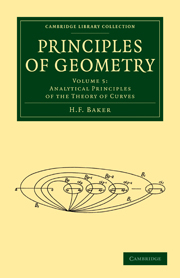Book contents
- Frontmatter
- PREFACE
- Contents
- CHAPTER I INTRODUCTORY ACCOUNT OF RATIONAL AND ELLIPTIC CURVES
- CHAPTER II THE ELIMINATION OF THE MULTIPLE POINTS OF A PLANE CURVE
- CHAPTER III THE BRANCHES OF AN ALGEBRAIC CURVE; THE ORDER OF A RATIONAL FUNCTION; ABEL'S THEOREM
- CHAPTER IV THE GENUS OF A CURVE. FUNDAMENTALS OF THE THEORY OF LINEAR SERIES
- CHAPTER V THE PERIODS OF ALGEBRAIC INTEGRALS. LOOPS IN A PLANE. RIEMANN SURFACES
- CHAPTER VI THE VARIOUS KINDS OF ALGEBRAIC INTEGRALS. RELATIONS AMONG PERIODS
- CHAPTER VII THE MODULAR EXPRESSION OF RATIONAL FUNCTIONS AND INTEGRALS
- CHAPTER VIII ENUMERATIVE PROPERTIES OF CURVES
- INDEX
CHAPTER V - THE PERIODS OF ALGEBRAIC INTEGRALS. LOOPS IN A PLANE. RIEMANN SURFACES
Published online by Cambridge University Press: 05 July 2011
- Frontmatter
- PREFACE
- Contents
- CHAPTER I INTRODUCTORY ACCOUNT OF RATIONAL AND ELLIPTIC CURVES
- CHAPTER II THE ELIMINATION OF THE MULTIPLE POINTS OF A PLANE CURVE
- CHAPTER III THE BRANCHES OF AN ALGEBRAIC CURVE; THE ORDER OF A RATIONAL FUNCTION; ABEL'S THEOREM
- CHAPTER IV THE GENUS OF A CURVE. FUNDAMENTALS OF THE THEORY OF LINEAR SERIES
- CHAPTER V THE PERIODS OF ALGEBRAIC INTEGRALS. LOOPS IN A PLANE. RIEMANN SURFACES
- CHAPTER VI THE VARIOUS KINDS OF ALGEBRAIC INTEGRALS. RELATIONS AMONG PERIODS
- CHAPTER VII THE MODULAR EXPRESSION OF RATIONAL FUNCTIONS AND INTEGRALS
- CHAPTER VIII ENUMERATIVE PROPERTIES OF CURVES
- INDEX
Summary
As has been indicated, at the present stage of the theory of algebraic geometry, many results find their clearest statement in connexion with the theory of algebraic integrals; just as the first exhaustive investigation of the genus of an algebraic curve was in fact by Abel, for the theory of algebraic integrals (Oeuvres, 1881, p. 145). And, notwithstanding the initial feeling which may arise, of the incongruity of the two theories, the geometrical reader will find it desirable to have an understanding of the main results of the latter theory. We therefore give now an account, with the objects, (i) of shewing how to determine the number of periods of an algebraic integral; (ii) of explaining the conception and use of the so-called Riemann surface; (iii) of making connexion with an arithmetic theory of plane curves. All these are helpful towards an extension of the theory of curves to the theory of surfaces; in particular, the geometrical aspect of the theory of Riemann surfaces is intimately related with a wide theory, Analysis Situs, or Topology, which promises to give a descriptive alternative to much involved computation. It must be understood that what we give is, in the space we allot to it, necessarily very incomplete. It will be sufficient if it indicate clearly the nature and bearings of the ideas involved; detailed developments will be found in many other places.
Meaning and number of periods. We suppose the independent complex variable x to be represented, in the known way, upon a Euclidean plane, regarded as closed at infinity by the single point x = ∞, like a sphere.
- Type
- Chapter
- Information
- Principles of Geometry , pp. 111 - 135Publisher: Cambridge University PressPrint publication year: 2010First published in: 1933

